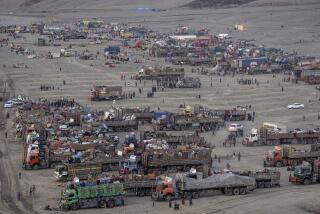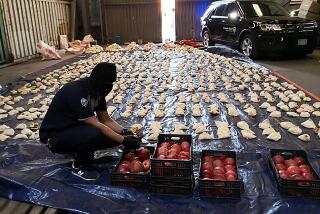Afghans Pin Reconstruction Hopes on Sale of Heroin Bound for Western Countries
- Share via
HESAR SHAHI, Afghanistan — Abdul Wasi is a success story of sorts since returning to this Afghan village after years of living in a refugee camp in Pakistan.
Wasi, 30, is one of several big opium farmers in Hesar Shahi in Afghanistan’s Nangarhar Province near the Pakistan border.
“I know that growing poppy is against Islamic principles, but I have to, in order to earn a living,” he said.
More than half of his 120 acres of land is planted with the pretty, purplish poppy flower that oozes the opium that ultimately is refined into heroin.
Wasi is growing twice as much poppy as last year, when he left Pakistan. “Next year, I will grow even more poppy, because I have to rebuild my destroyed house,” he said.
The U.S. Drug Enforcement Agency estimates the opium crop in Afghanistan at 800 tons this year, based on satellite photographs. Aid workers in Peshawar, the hub of Afghan refugee life, say the crop could reach 2,000 tons--nearly the same as Burma, the world’s leading opium producer.
“I don’t think it matters whether it’s 800 tons or 2,500 tons,” said Andrew Price, a program director with the United Nations Drug Control Project (UNDCP) in Peshawar. He refused to hazard an estimate about the size of the crop.
“It’s definitely increasing. It’s like a cancer growing around them,” Price said, adding that 10% to 15% of the 2 million refugees in Pakistan are opium or heroin addicts.
“We’re obviously concerned that drug addicts are going back to encourage opium poppy farming,” he said.
Almost all of the heroin addicts smoke it in pipes--”chasing the dragon”--but Price said it is only a matter of time before they turn to needles and unleash a possible AIDS nightmare on war-ravaged Afghanistan.
The opium is usually bought by local drug dealers who then smuggle it by mule teams across the open border at the Khyber Pass to heroin laboratories in the tribal areas of Pakistan’s North-West Frontier province, narcotics experts say.
Price said more and more heroin was being refined in Afghanistan itself to get the “value added.” Refined heroin was also much easier to smuggle out than bulk opium, he said.
The refined heroin is sent to Western countries via various routes--by ship from Karachi or Bombay, or overland through Iran and Central Asia to Europe.
Heroin is now playing a major role in the reconstruction of Afghanistan, shattered by 14 years of war that killed 2 million people and created 5 million refugees, aid workers say.
When the United States cut off military supplies to moujahedeen rebels two years ago, many rebel commanders were accused of ordering farmers to grow poppy to finance the war effort.
Narcotics and aid officials say the fall of former President Najibullah and the emergence of a moujahedeen government in Kabul will probably not make much of a difference to the booming opium trade in the impoverished country.
“We have to pay medical, food and clothing costs, if we do not grow poppy how can we pay these expenses,” said Salim, 22, in the Nangarhar town of Deh Bala.
Farmers here in the remote Koghiana Valley at the foot of the Hindu Kush Mountains say they can harvest 30 to 40 pounds of opium or half a ton of wheat on a small plot of land. The opium fetches the equivalent of $22 a pound and the wheat about 11 cents a pound.
Price said the UNDCP is trying to offset the greed and need of farmers--and their fear of local drug barons--by funding construction of schools, clinics and roads in poppy-free areas.
“They have to accept they’ll have less money for the wheat but they’ll have something of more value to the community and social structure,” he said.
But the governor of Nangarhar province, Haji Qader, said such programs had not been successful.
More to Read
Sign up for Essential California
The most important California stories and recommendations in your inbox every morning.
You may occasionally receive promotional content from the Los Angeles Times.













